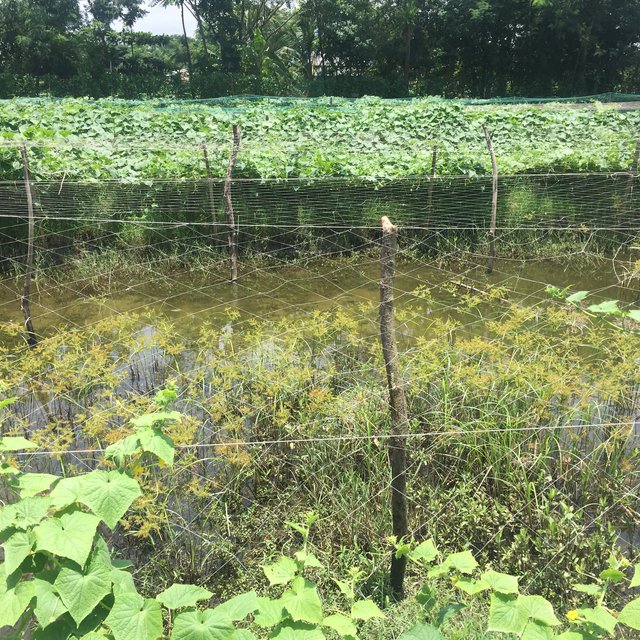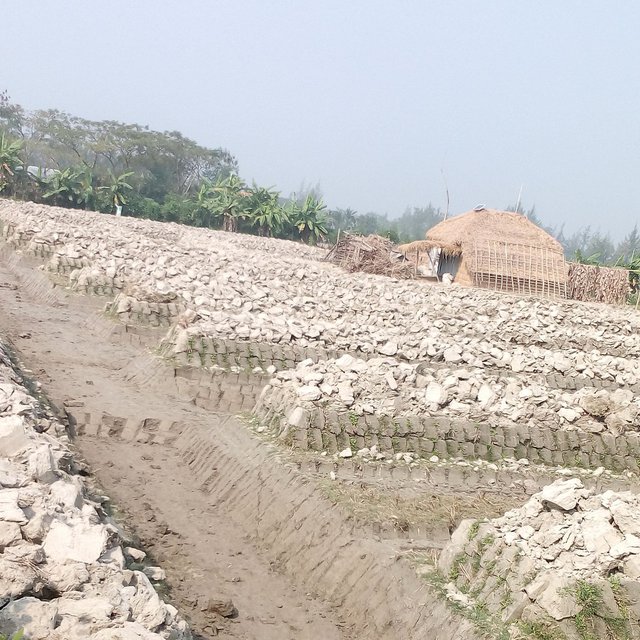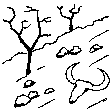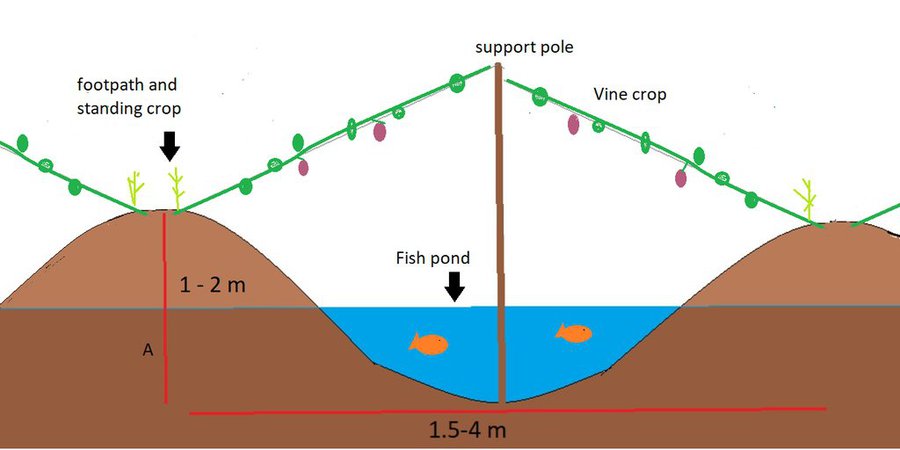



The Sorjan is a system that serves as an alternate of deep drains (ditches) and raised beds for crop cultivation and fish rearing. In coastal Bangladesh the ridges are mostly around one meter wide at the top and spaced two meters apart – although in places ridges and spacing can be wider than this. The Sorjan system is applied in lowland areas which suffer from water logging and salinization. The widely spread technology is also practiced in Char Nangulia, Noakhali district in the Meghna estuary in Bangladesh. The main economic activities in this area are small-scale agriculture, livestock keeping, fish rearing and informal business. Before introduction of the Sorjan system (by the Bangladesh by Department of Agriculture Extension) only deep-water tolerant traditional low-yielding paddy could be cultivated during the rainy season and in the dry season, the capillary rise of salty ground water led to poor yields for most crops, if they survived at all.
The beds are about 60 to 90 cm high, which means crops are kept above the water, even during the wet season. The ditches between the ridges hold water for six to eight months per year and can be used to rear fish and ducks as well as being a source of water to irrigate the crops. In most cases nets are spanned over the ditches, allow climbing plants to grow over them utilizing the space in an efficient way. The sorjan system is is applied in low land areas and frequently suffer from water logging and sometimes salt water intrusion. This system with raised bed enables the cultivation of vegetables in these locations.
The main function of Sorjan is to grow crops on raised beds so that roots are protected against stagnant water. As the area is partially excavated, the deeper areas can be used for fish rearing whenever inundated and crops such as cucumber and gourds can grow vines on supporting nets spanned over the ditches to maximize productivity of limited space available. In the Philipines Sorjan system, it has also been reported that rice is cultivated in the ditches with shallow water and at the same time, other crops on the beds.
To install Sorjan a farmer needs to make raised beds for planting the crops and rear fish in the deep drains. This is usually done by hand with help of local laborers, in some cases an excavator is rented to do the job. To support the crop to be planted , a framework of bamboo, string and netting is built over the ditches to support a sequence of climbing plants.
Maintenance of the beds is done regularly whenever necessary and the crop netting is replaced every 3 years. In the area farmers predominantly use urea and other chemical fertilizers to lesser extent, few farmers use animal manure and compost. Most Sorjan ridges have a permanent undergrowth of grass to keep the slopes stable. In some cases, during dry season, goats graze the grass in the ditches and slopes.
Before the rains start in March, cucumbers are planted, and these are followed by a variety of gourds (including snake, bottle, bitter and ribbed gourds) in the early monsoon, with yard long bean (asparagus bean) and country bean (lablab bean) in the later monsoon, with country beans continuing to be harvested through the dry season up to the following March. During dry season the beans are sometimes intercropped with chillies, tomatoes and amaranth. These crops overlap with each other, with relay cropping allowing continuous harvesting for 9 or 10 months per year (early June to March).
The significant increase of income a small-holder farmer can make in the area alongside having fresh fish and vegetable for the greater part of the year have been reasons for farmers taking up Sorjan. The Sorjan system is propagated as a measure to mitigate effects of increased salinity and/or water logging due to sea-level rise. Sorjan does not facilitate any mechanization as the narrow beds and ditch bottoms are only accessible by foot.

الموقع: Char Nangulia, Chittagong Division, Noakhali District, بنغلاديش
عدد مواقع تنفيذ التقنيةالتي تم تحليلها: 100 - 1000 موقع
انتشار التقنية: يتم تطبيقها في نقاط محددة/ تتركز على مساحة صغيرة
في منطقة محمية بشكل دائم؟: كلا
تاريخ التنفيذ: منذ أقل من 10 سنوات (مؤخرًا)
نوع التقديم








| تحديد المدخلات | الوحدة | الكمية | التكاليف لكل وحدة (BDT) | إجمالي التكاليف لكل مدخل (BDT) | % من التكاليف التي يتحملها مستخدمو الأراضي |
| العمالة | |||||
| excavation, bed construction and suspending of nets | person-days | 40,0 | 200,0 | 8000,0 | 100,0 |
| معدات | |||||
| shovels, baskets and other equipment | lump sum | 2000,0 | 100,0 | ||
| مواد البناء | |||||
| poles + netting | lump sum | 1,0 | 30000,0 | 30000,0 | |
| إجمالي تكاليف إنشاء التقنية | 38'000.0 | ||||
| إجمالي تكاليف إنشاء التقنية بالدولار الأمريكي | 447.06 | ||||
| تحديد المدخلات | الوحدة | الكمية | التكاليف لكل وحدة (BDT) | إجمالي التكاليف لكل مدخل (BDT) | % من التكاليف التي يتحملها مستخدمو الأراضي |
| العمالة | |||||
| repair of beds | |||||
| replacement of netting structure | |||||
| المواد النباتية | |||||
| Inputs production (seeds crops, fertilizers and fish feed) | |||||
| غير ذلك | |||||
| fish fry | |||||
Areas which received support of the Char Development and Settlement Project have much better access to infrastructure and services.
single annual low-yield rice crop (< 1 t/ha) to year-round vegetables
fish rearing activities in areas previously used for paddy only
reduced risk of crop losses due to flooding or salinity
single annual rice crop to year-round various vegetables
Measure does not increase production area, but does allow more than 1 cropping season per year.
Farmers using Sorjan report to cultivate more cash crops than before and are no longer dependent on food purchase for vegetables
Fallow period has become shorter by (almost) continuous cropping
No decrease of overall salinity, but effect on crop has shown to decrease
continuous crop cover is likely increase soil organic matter
increased diversity of crops cultivated in area
from plane field to alternated high ridges and low wet areas.